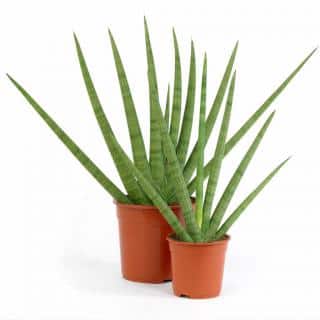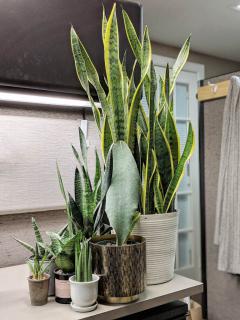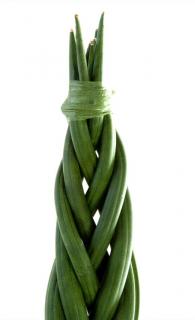

Sansevieria, also called Mother-in-law’s tongue and snake plant, has nice leaves.
Simple Sansevieria facts
Name – Sansevieria
Family – Liliaceae (lily family)
Type – indoor plant
Height – 1½ to 5 feet (0.5-1.5 m)
Exposure – well-lit
Soil: soil mix + sand – Flowering: early spring (rare)
Its leafage is original and elegant. The plant is very resistant, especially to heat. Each variety boasts trendy traits that home designers like Nikki (photo author, top) make use of to decorate interiors.
Sansevieria requires good light but fears direct sun that would tend to speed the plant’s dehydration. Too much sun would quickly dry up the leafage. It would then take on a yellow hue for a long time.
Although the plant tolerates light shade, growth will be slowed.
Try to place it near a window that gets plenty of light, but avoid having the sun’s rays hit it.
A house or apartment is perfect, because the ideal range is from 65 to 70° F (18 to 21° C) all year round.
Sansevieria is unhappy when temperatures drop below 55°F (12°C).
From May to September, you can bring your plant outdoors without any problems. Bring it back inside in the evening if nights are cold.
Watering must be moderate but regular, more or less once a week. Best is to water when the surface of the soil has dried out. Don’t wait too long, especially if it is hot. The plant will suffer from it.
If tap water in your area is hard, try to collect rainwater.
Lukewarm water is better than cold water. The T° gap could stress your sansevieria.
Slowly restrict watering during the dormant state. Wait for the soil to dry off to about an inch deep (a few cm) before watering again. Use lukewarm water instead of cold tap water.

Once every 3 years at most, repot your Sansevieria in spring.
When repotting, choose a pot that is slightly wider across than the previous. It shouldn’t be too large. Check that the bottom lets water drain out through holes.
The roots are very powerful. If you don’t repot on time, your plant will simply swell and burst the pot!
This plant is extremely robust and can fend off most diseases.
Although it is sometimes visited by mealy bugs, its main enemy is moisture. Too much water can lead roots and leaves to rot.
There are over 70 species within the family. Many of them have several cultivars or varieties.
 Sansevieria cylindrica – a notable variety is S. cylindrica ‘Boncel’. Leaves curl and form a thick cylinder. Single-leafed varieties also go under the name “Spear Sansevieria”. They’re sometimes braided for a playful effect.
Sansevieria cylindrica – a notable variety is S. cylindrica ‘Boncel’. Leaves curl and form a thick cylinder. Single-leafed varieties also go under the name “Spear Sansevieria”. They’re sometimes braided for a playful effect.
Leaf cuttings is one of the easiest ways to propagate this plant if you want to leave the mother plant undisturbed.
You can also simply divide the clump, as shown for this ZZ plant division.
Splitting parts of the rhizome (roots) will also trigger new shoots in each.
You’ll be surprised by how small the roots are compared to the size of the leaves! Work carefully to avoid breaking them because the whole plant depends on those few roots.

Sansevieria is actually kin to another family that is famous for houseplants, the Dracaena family.
This plant isn’t afraid of heat. If you check soil moisture often, you can even set it up near sunny windows or heat sources!